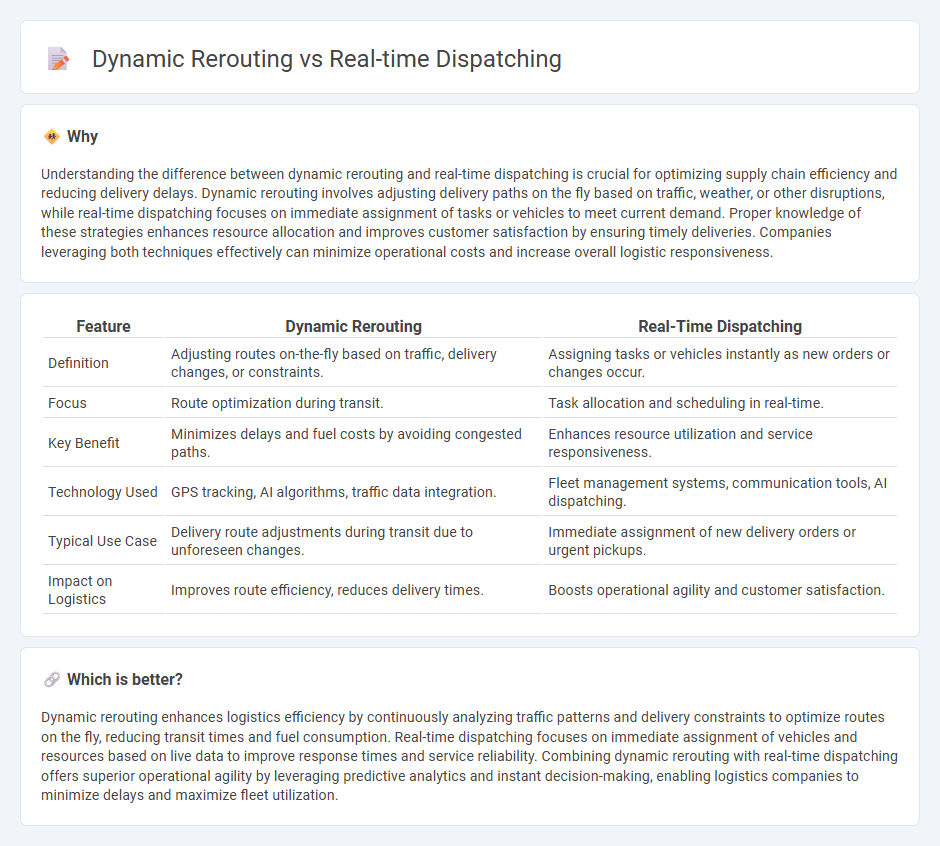
Dynamic rerouting leverages advanced algorithms and real-time data to optimize delivery paths, reducing transit times and fuel consumption. Real-time dispatching focuses on immediate assignment of tasks to available resources, enhancing responsiveness and operational efficiency. Explore how integrating these technologies transforms modern logistics management.
Why it is important
Understanding the difference between dynamic rerouting and real-time dispatching is crucial for optimizing supply chain efficiency and reducing delivery delays. Dynamic rerouting involves adjusting delivery paths on the fly based on traffic, weather, or other disruptions, while real-time dispatching focuses on immediate assignment of tasks or vehicles to meet current demand. Proper knowledge of these strategies enhances resource allocation and improves customer satisfaction by ensuring timely deliveries. Companies leveraging both techniques effectively can minimize operational costs and increase overall logistic responsiveness.
Comparison Table
| Feature | Dynamic Rerouting | Real-Time Dispatching |
|---|---|---|
| Definition | Adjusting routes on-the-fly based on traffic, delivery changes, or constraints. | Assigning tasks or vehicles instantly as new orders or changes occur. |
| Focus | Route optimization during transit. | Task allocation and scheduling in real-time. |
| Key Benefit | Minimizes delays and fuel costs by avoiding congested paths. | Enhances resource utilization and service responsiveness. |
| Technology Used | GPS tracking, AI algorithms, traffic data integration. | Fleet management systems, communication tools, AI dispatching. |
| Typical Use Case | Delivery route adjustments during transit due to unforeseen changes. | Immediate assignment of new delivery orders or urgent pickups. |
| Impact on Logistics | Improves route efficiency, reduces delivery times. | Boosts operational agility and customer satisfaction. |
Which is better?
Dynamic rerouting enhances logistics efficiency by continuously analyzing traffic patterns and delivery constraints to optimize routes on the fly, reducing transit times and fuel consumption. Real-time dispatching focuses on immediate assignment of vehicles and resources based on live data to improve response times and service reliability. Combining dynamic rerouting with real-time dispatching offers superior operational agility by leveraging predictive analytics and instant decision-making, enabling logistics companies to minimize delays and maximize fleet utilization.
Connection
Dynamic rerouting and real-time dispatching are interconnected through their reliance on live data analytics and GPS tracking to optimize delivery schedules and routes. These technologies enable logistics providers to respond instantly to traffic conditions, vehicle breakdowns, or unexpected delays, enhancing operational efficiency. Real-time dispatching coordinates immediate decision-making while dynamic rerouting adapts routes on-the-fly, collectively minimizing fuel costs and improving customer satisfaction.
Key Terms
GPS Tracking
Real-time dispatching leverages GPS tracking to continuously monitor fleet locations, enabling immediate assignment of the nearest available vehicle to new tasks for optimal efficiency. Dynamic rerouting uses GPS data to adjust delivery or service routes in real-time based on traffic conditions, delays, or last-minute changes, reducing travel time and fuel consumption. Explore how integrating advanced GPS tracking can transform logistics operations with real-time dispatching and dynamic rerouting strategies.
Route Optimization
Real-time dispatching improves operational efficiency by assigning tasks instantly based on current vehicle locations and traffic data, while dynamic rerouting continuously adjusts routes to avoid delays and optimize delivery times. Route optimization algorithms leverage real-time data to reduce fuel consumption, travel time, and operational costs, enhancing overall fleet productivity. Explore comprehensive solutions to maximize route efficiency and streamline dispatching with advanced route optimization technologies.
ETA Updates
Real-time dispatching utilizes live vehicle tracking and traffic data to assign tasks promptly, enhancing ETA accuracy by continuously monitoring fleet locations and conditions. Dynamic rerouting adjusts planned routes on the fly based on traffic congestion, accidents, or delivery priorities, improving arrival times and minimizing delays. Explore in-depth how these technologies revolutionize ETA updates for optimized logistics performance.
Source and External Links
Real-Time Truck Dispatch Systems and Tracking Software - Real-time dispatching in the construction industry utilizes GPS and telematics to improve scheduling, resource utilization, and decision-making, replacing outdated communication methods for enhanced operational efficiency and customer satisfaction.
What is Real-Time Dispatching? - Real-time dispatching automates and updates trip scheduling dynamically, reduces human error and operational delays, and provides live tracking and route adjustments to improve efficiency and customer satisfaction in transportation services.
Real time dispatch in Fabs - Real-time dispatching in manufacturing fabs balances work-in-progress flow across production lines by combining global prioritization rules with local optimizations to maximize throughput and reduce bottlenecks.
 dowidth.com
dowidth.com